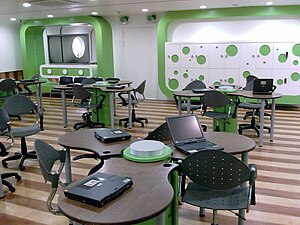
A Small study on use of interactive e-learning in Medicine
all words <within> are mine.
Technology used- live interactive webcasting using a scan converter, mixer, and digitizer, and video server to embed a presenter-controlled talking head or copy of the presenter’s computer screen (normally a PowerPoint slide) in a student chat room.
Activity studied - 16 students from six countries underwent weekly 2.5-hour live sessions for 10 weeks.<small size, but lets not be choosy.>
Content used included the use of computers by patients, patient access to records, different forms of e-learning for patients and professionals, research methods in eHealth, geographic information systems, and telehealth. - <bias galore!>
Conclusion- The model of synchronous e-learning based on interactive live webcasting was a successful method of delivering an international postgraduate module. Students found it engaging over a 10-week course. Although this is a small study, given that synchronous methods such as interactive webcasting are a much easier transition for lecturers used to face-to-face teaching than are asynchronous methods, they should be considered as <important>part of the blend of e-learning methods.
Detailed study here-
Use of Live Interactive Webcasting for an International Postgraduate Module in eHealth: Case Study Evaluation | Jones | Journal of Medical Internet Research
No comments:
Post a Comment